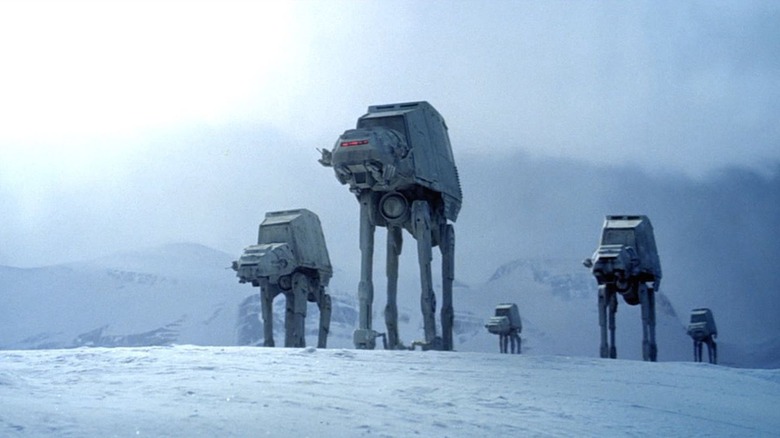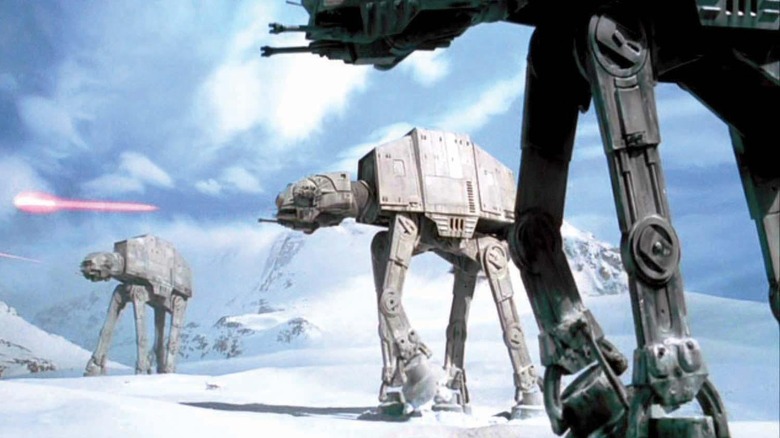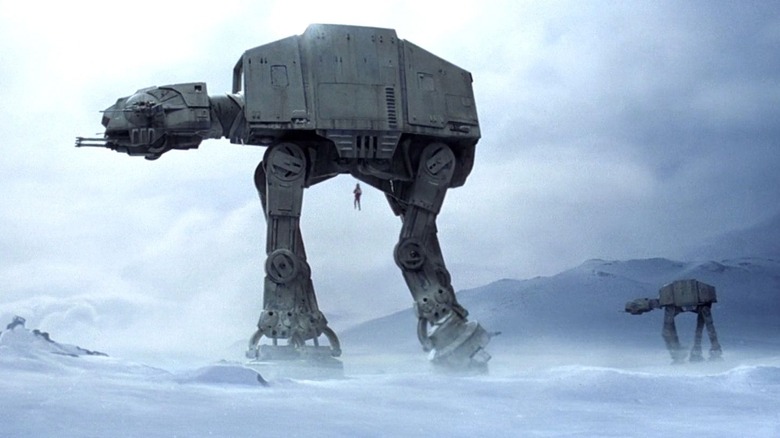The Star Wars Crew That Created The AT-AT Never Cared For The Name
The opening of Irvin Kershner's 1980 film "The Empire Strikes Back" didn't leave viewers with must cause for hope. The ending of its predecessor "Star Wars" saw the evil Empire more or less destroyed. A brave cadre of scrappy rebels had gathered in a team of battle crafts to attack and destroy the moon-sized Death Star, a powerful weapon that could destroy an entire planet with one laser blast. With the Death Star destroyed, it appeared that the Good Guys won and the Bad Guys were vanquished.
"The Empire Strikes Back" revealed that the Empire was very much still alive, and was now seeking retribution. The Rebels had taken to hiding out on a remote, frozen world called Hoth, populated only by two-legged beasts of burden and the occasional yeti. The underground rebels' base, however, was almost immediately located by the Empire, and the villains commenced a forward military assault on it.
The tank-like weapons used by the Empire were towering, armored, elephant-shaped machines that walked on four enormous mechanical legs. According to "Star Wars" toy boxes, these vehicles were called All-Terrain Armored Transports, or AT-ATs. There seems to be some controversy as to whether or not "AT-AT" is pronounced as "at at" or "A.T.A.T."
The AT-ATs in "Empire" were realized by Joe Johnston, Dennis Muren, and Phil Tippett who, between them, designed and animated them in stop-motion. In a 2020 oral history of "Empire" on StarWars.com, Johnston talked about his process in bringing the AT-ATs to life, and how everything was perfect ... except the silly name.
The history of metal
Joe Johnston revealed to StarWars.com that his ideas for the AT-ATs began with a study of metallurgic futurism, rather than at the sketch pad. The "Star Wars" movies make use of all kinds of unusual futuristic technology, and the filmmakers wanted the fictional machines to look like something might in real life in a few centuries. Johnston even remembers the industry catalog he thumbed through to get ideas as to how metals would look in the future. He said:
"I had remembered from Cal State Long Beach, there was a portfolio that U.S. Steel had published. It was all about, 'This is how steel is going to be used in the future.' It was paintings by Syd Mead. They gave these portfolios — I think there were 12 illustrations — to design schools and students. They published them with no copyright at all. 'What we're saying is, this is the future.' One of the illustrations in there was a truck that walked on four legs. The illustration of it was walking through this snowy forest and I thought, 'That is really cool.'"
Thanks to the thoroughness of the internet, Syd Mead's invention is available. His paintings, painted in 1969, can be seen on the website CyberneticZoo. The walking truck was a cargo vehicle meant to traverse uneven terrain. The U.S. Military had even funded the invention of such a vehicle. One can see the AT-AT scene in Mead's painting, right down to the icy terrain. The walking cargo truck wasn't as animal-like, however, possessing a standard driver's cab.
Making it military
Joe Johnston then extrapolated a military attack vehicle from the walking cargo truck. Here's how he described it to StarWars.com:
"I took the idea of this machine that walks on four legs and I made it, basically, a military vehicle with a separate head. As I remember it, the Syd Mead illustration was sort of all one piece. It was the truck body and sort of a cab up front. I don't think it was a separate head. I took that and started working up designs using that basic idea of a tank that walks on four feet through the snow, and that became the snow walker."
In the film, the AT-ATs also needed to be large and impenetrable. "Star Wars" fans will point out that Luke Skywalker (Mark Hamill) will find that his airplane's weapons cannot penetrate the AT-AT's hull, so he wraps a towing cable around its legs, causing it to fall over and explode. It seems Johnston located the AT-AT's biggest design flaw. As for the name, well, that wasn't something Johnston or any of the technicians had any control over. He said:
"We never referred to it as the AT-AT. We hated that name. We just called it the snow walker."
This, of course, is a clear indicator that any and all "Star Wars" fans should now feel obligated to refer to the vehicles from "The Empire Strikes Back" as Snow Walkers. Adjust your canonical knowledge accordingly. Also, pick up a book by Syd Mead. He is an important figure in sci-fi movie design.


